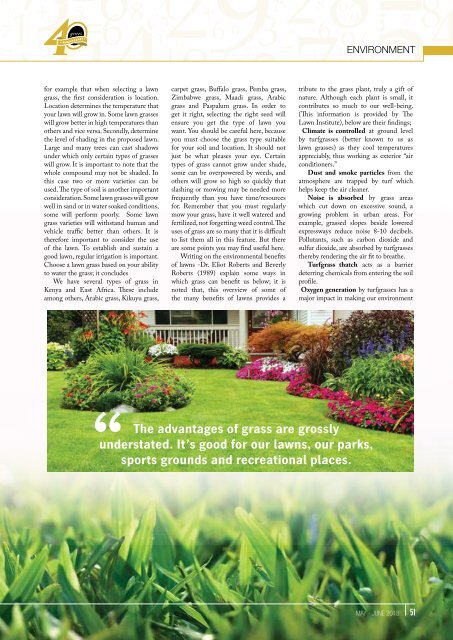May-June-issue
You also want an ePaper? Increase the reach of your titles
YUMPU automatically turns print PDFs into web optimized ePapers that Google loves.
ENVIRONMENT<br />
for example that when selecting a lawn<br />
grass, the first consideration is location.<br />
Location determines the temperature that<br />
your lawn will grow in. Some lawn grasses<br />
will grow better in high temperatures than<br />
others and vice versa. Secondly, determine<br />
the level of shading in the proposed lawn.<br />
Large and many trees can cast shadows<br />
under which only certain types of grasses<br />
will grow. It is important to note that the<br />
whole compound may not be shaded. In<br />
this case two or more varieties can be<br />
used. The type of soil is another important<br />
consideration. Some lawn grasses will grow<br />
well in sand or in water soaked conditions,<br />
some will perform poorly. Some lawn<br />
grass varieties will withstand human and<br />
vehicle traffic better than others. It is<br />
therefore important to consider the use<br />
of the lawn. To establish and sustain a<br />
good lawn, regular irrigation is important.<br />
Choose a lawn grass based on your ability<br />
to water the grass; it concludes<br />
We have several types of grass in<br />
Kenya and East Africa. These include<br />
among others, Arabic grass, Kikuyu grass,<br />
carpet grass, Buffalo grass, Pemba grass,<br />
Zimbabwe grass, Maadi grass, Arabic<br />
grass and Paspalum grass. In order to<br />
get it right, selecting the right seed will<br />
ensure you get the type of lawn you<br />
want. You should be careful here, because<br />
you must choose the grass type suitable<br />
for your soil and location. It should not<br />
just be what pleases your eye. Certain<br />
types of grass cannot grow under shade,<br />
some can be overpowered by weeds, and<br />
others will grow so high so quickly that<br />
slashing or mowing may be needed more<br />
frequently than you have time/resources<br />
for. Remember that you must regularly<br />
mow your grass, have it well watered and<br />
fertilized, not forgetting weed control. The<br />
uses of grass are so many that it is difficult<br />
to list them all in this feature. But there<br />
are some points you may find useful here.<br />
Writing on the environmental benefits<br />
of lawns -Dr. Eliot Roberts and Beverly<br />
Roberts (1989) explain some ways in<br />
which grass can benefit us below; it is<br />
noted that, this overview of some of<br />
the many benefits of lawns provides a<br />
tribute to the grass plant, truly a gift of<br />
nature. Although each plant is small, it<br />
contributes so much to our well-being.<br />
(This information is provided by The<br />
Lawn Institute), below are their findings;<br />
Climate is controlled at ground level<br />
by turfgrasses (better known to us as<br />
lawn grasses) as they cool temperatures<br />
appreciably, thus working as exterior “air<br />
conditioners.”<br />
Dust and smoke particles from the<br />
atmosphere are trapped by turf which<br />
helps keep the air cleaner.<br />
Noise is absorbed by grass areas<br />
which cut down on excessive sound, a<br />
growing problem in urban areas. For<br />
example, grassed slopes beside lowered<br />
expressways reduce noise 8-10 decibels.<br />
Pollutants, such as carbon dioxide and<br />
sulfur dioxide, are absorbed by turfgrasses<br />
thereby rendering the air fit to breathe.<br />
Turfgrass thatch acts as a barrier<br />
deterring chemicals from entering the soil<br />
profile.<br />
Oxygen generation by turfgrasses has a<br />
major impact in making our environment<br />
The advantages of grass are grossly<br />
understated. It’s good for our lawns, our parks,<br />
sports grounds and recreational places.<br />
MAY - JUNE 2018 51

















